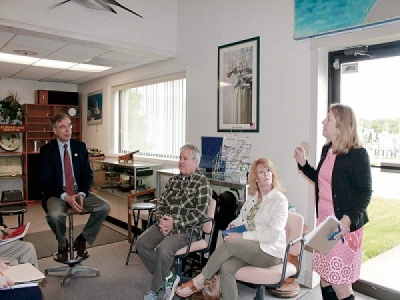
Posted on May 23, 2017
By Katie Tabeling, OC Today
Local watermen and other fishing industry representatives urged Rep. Andy Harris (R-1st) last week to lean harder on the Army Corps of Engineers to find a solution to the sandbars and shoals that are hampering navigation of the Ocean City Inlet area.
The corps is gathering information on the 53-foot scour hole near Homer Gudelsky Park (previously known as Stinky Beach) and its impacts on local waters. But fishermen told Harris during a meeting at L & L Marine Equipment in West Ocean City that the solution was simple: reconfigure the Assateague Island jetties.
“It’s been studied to death, and if they studied it, they studied it wrong,” Bahia Marina owner Shawn Harman said. “We see this every day. We live it. It doesn’t take a rocket scientist to see that extending the south jetty at Assateague is causing us problems. It creates a big hook that catches everything.”
The Army Corps of Engineers built the jetty to stabilize Ocean City’s inlet when it was shaped by a hurricane in 1933. Before that, the resort and Assateague Island were contiguous. Over the years, sand washed away from Ocean City’s beach is deposited on Assateague in a north-to-south movement.
But two years after Hurricane Sandy hit the island, sand began been building up faster between the two islands, calling for increased amount of dredging.
At the moment, the dredge Murden is working the channel, focusing on the shoals were sand is trapped while moving south to Assateague. Of the estimated 35,000 cubic yards expected to be dredged, roughly 10,000 will be pulled from the channel.
“When I used to work on a boat, you could go right through the channel and not follow the buoys. There’s so much sand in there now,” Merrill Campbell of Southern Connection Seafood said.
“Three years ago, it was only big commercial clammers, drawing 10 to 12 feet that were having issues. Now it’s recreational yachts in the 5- to 6-foot draft range that are getting hung up in the same area,” George Topping added.
While there’s no definitive answer to why shoaling increased since Hurricane Sandy, watermen also theorized that the beach replenishment project could have something to do with it.
“They’re taking out the bottom [of the ocean] and putting it back on the beach in the fall. In December, we have nor’easters, and all that sand is bedded down. That sand [from beach replenishment] is coming down to this shoal,” Campbell said. “It’s not what the corps intended, but that’s what happened. I understand we need beach replenishment, but we need a solution.”
The increase in shoaling is also a serious issue in terms of Ocean City’s economy. Several commercial vessels have ceased operations in Ocean City, with their captains and owners contending the trouble isn’t worth it.
Campbell estimated that one boat could provide millions to local economy in terms of seafood, marina costs, restaurants and lodging expenses.
Another issue, according to fishing industry representatives, is that traditional fishing grounds are vanishing because of the shoals.
“A lot of fishing grounds with two-mile shoals are gone now,” Topping said. “And with those big waves that pound on the beach during those storms… it’s a no-win situation.”
Harris said he did not have a solution, but made several suggestions that could be discussed with the Army Corps of Engineers during his meeting in June.
“Assateague shouldn’t suffer by extending the north jetty,” he said. “We could also change dredging so that everyone puts a little [money] in, state and local, with the Army Corps putting in a lion’s share. That’s how they started beach replenishment. We could even move beach replenishment to the spring.”
Harris was also surprised to hear that the corps’ study on the inlet was significantly scaled back.
At the end of 2015, Congress approved the Army Corps’ Continuing Authorities Program, which contains a number relatively smaller projects relating to regional sediment management. A hydrodynamic study on the inlet was one of the first projects approved, but later was narrowed to focus on Stinky Beach.
“We specifically asked for an overall study, not of one area,” Harris said.
A larger study of the entire inlet would take too long and cost too much, corps officials said. A 1998 study of the inlet recommended dredging to 16 feet, but no action was taken.
Source: OC Today





